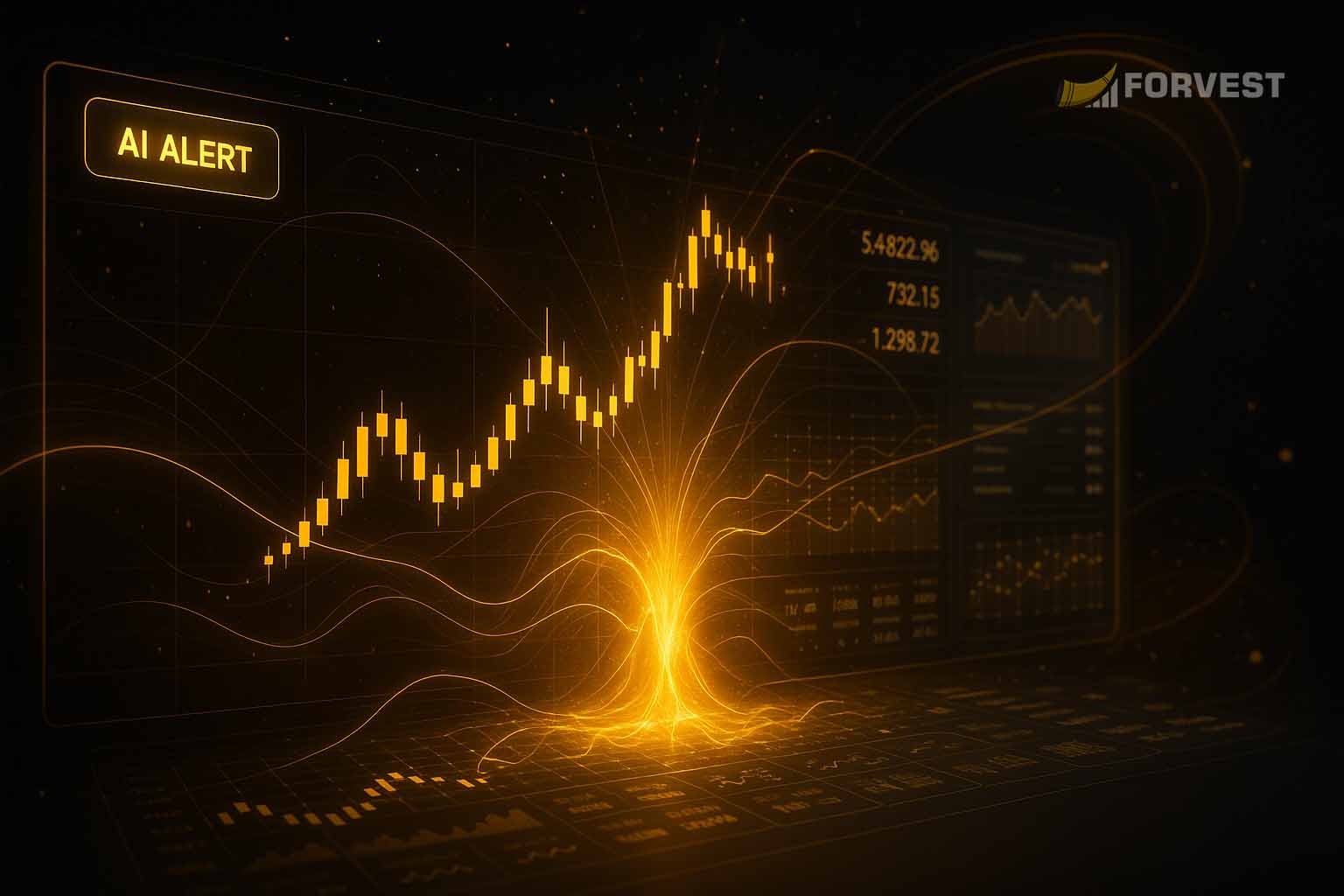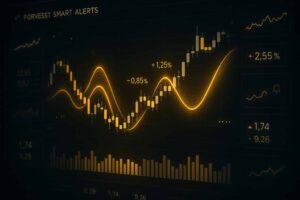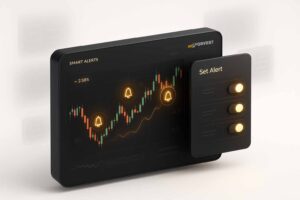Smart Alerts for Faster, Better Crypto Trading
Trade smarter with real-time AI alerts.

“Learn how smart alerts can transform your crypto trading in 2025. This Forvest guide explains real-time alert tools, setup methods, use cases, and strategies to make faster, data-driven trading decisions — supported by Forvest Trust Score analytics.” Crypto markets never sleep, so timely signals are vital. Smart alerts automate market monitoring, sending notifications when conditions you set occur. This means you can act faster on opportunities or risks without obsessively watching charts.
- Smart alerts are automated crypto notifications triggered by custom market events.
- They help traders react quicker (for example, Binance’s alerts let users “catch early opportunities and dodge unexpected dips”) and manage risk more proactively.
- This guide covers everything from setting up alerts to best practices and tools, with Forvest analytics guiding your strategy.
What Are Smart Alerts in Crypto?

Smart alerts are automated trading signals triggered by predefined conditions. Think of them as personalized market alarms. When your chosen event happens – say, Bitcoin reaches $60,000 or an altcoin’s 24h volume spikes 50% – the system sends you a notification. Nansen describes smart alerts as customizable notifications (via Telegram/Discord/etc.) that fire whenever an on-chain activity or market event meets your conditions. Similarly, Forvest explains alerts as “alarms set for market movements” to keep you informed 24/7.
Practically, alerts can track: price thresholds, volume surges, chart patterns, news events, and more. For example, Coinbase’s price alerts notify you “when the prices of [assets] shift substantially up or down,” by a percentage you choose. Forvest’s own alert system (the Fortuna Alert tool) lets you set price triggers or percent-change targets and delivers an immediate Telegram message when hit. In short, alerts automatically watch the market for you and send a heads-up exactly when something important happens.
Benefits of Using Smart Alerts for Traders
The main advantage of smart alerts is speed and efficiency. By notifying you immediately of key events, they let you act faster than manual monitoring. For example, Binance notes that its alerts help traders “catch early opportunities and dodge unexpected dips”. This rapid awareness can lock in profit when prices surge or limit losses during sudden drops. Alerts also free you from constant screen time: you get notified on your mobile or email instead of endlessly scanning charts.
Smart alerts are also a risk-management tool. They can warn you about rapid volatility, pending liquidations, or large market moves before they fully play out. Forvest analysis found that traders using smart alerts made position adjustments roughly 25% faster during volatile periods (as of Sept 2025).
What this means for you:
with faster alerts, you have more time to fine-tune or exit trades. That extra cushion can mean better entry/exit prices and less stress. By responding to data instead of hearsay, you keep emotions in check. (Investopedia even advises using alerts to manage volatility but warns against obsessing over every tiny move. Smart alerts solve this by focusing only on thresholds you consider important.)
Setting Up Smart Alerts: Step-by-Step Guide

Setting up smart alerts involves a few key steps:
- Define Your Alert Goals: Decide which market events you care about. This could be price levels (e.g. BTC > $50,000), technical signals (e.g. RSI oversold), or on-chain events (e.g. a whale transfer). Focus on a few high-impact conditions to start.
- Choose a Platform: Many exchanges and tools offer alerts. For instance, Binance’s app lets you configure Alpha Alerts; TradingView allows custom chart alerts; Coinbase Wallet (with Notifi) gives on-chain alerts. Pick one that covers your needs.
- Configure Alert Conditions: In the platform’s alert menu, specify the triggers. For example, set a price threshold, percentage change, or indicator cross. Choose your delivery method – mobile push, email, or messaging (some platforms even support Telegram or Discord).
- Calibrate with Quality Filters: Enhance reliability by incorporating factors like volume or trend to avoid false signals. Using Forvest’s Trust Score Analysis framework, for instance, can help prioritize alerts with high-quality signals. Apply such filters or combine multiple criteria so alerts fire only for noteworthy moves.
- Test and Activate: Simulate or wait for a test trigger to verify the alert works. Adjust sensitivity if you get too many false alarms. Once satisfied, save the alert. From here on, it will run continuously and notify you when conditions are met.
By following these steps, your alerts will be tailored and reliable, seamlessly integrating into your trading workflow.
Types of Smart Alerts You Can Use
Smart alerts can track various kinds of events. Common alert types include:
| Alert Type | Example Trigger |
| Price Alerts | Bitcoin exceeds $50,000 or drops 3% in an hour |
| Technical Alerts | RSI crosses below 30, MACD crossover, or moving-average cross |
| On-Chain Alerts | 500 BTC moved to an exchange, new token launch, large whale transfer |
| News/Sentiment | Breaking news on a coin, social media mention spike |
| Portfolio Alerts | Portfolio value dips 5%, or an asset hits a gain threshold |
Source: Forvest analysis (Oct 2025).
Each type serves different strategies. Price and technical alerts monitor market moves; on-chain alerts catch blockchain events; news alerts react to sentiment or announcements; portfolio alerts watch your holdings. Together, they create a comprehensive notification system. For details on specific categories, see our guide on different types of crypto trading alerts.
Best Practices for Utilizing Smart Alerts
To make smart alerts truly effective, follow these best practices. First, focus on signal quality over quantity. Set only a few critical alerts rather than a flurry of minor ones. Use trusted filters – for example, apply Forvest Trust Score to emphasize signals backed by data – so that only high-value alerts come through. Calibrate your triggers carefully: avoid too-tight thresholds that spam you, and avoid too-broad ones that miss moves. Experts often recommend multi-factor triggers (e.g. require both a price jump and volume surge) to reduce false alarms.
Second, diversify delivery channels. Send alerts to both your phone and email (or a messaging app). This way, you’re less likely to miss a signal if one device is off. Third, review and refine regularly. Markets evolve, so review your alert history periodically. Disable alerts that fire too often without profit, and adjust others based on performance. Alerts are tools, not guarantees – always double-check a triggered alert against charts or multiple sources before acting. By treating alerts as guidance (not gospel), you keep control of your strategy.
Remember, even the best alerts can’t predict every move. Use them to supplement (not replace) good risk management practices like stop-losses and diversified positions. Overall, smart alerts should reduce stress and enhance decision-making.
what this means for you:
less frantic monitoring and more confidence in your trades.
Popular Tools and Platforms Offering Smart Alerts
Many crypto platforms now include smart alert features. For example, Binance’s Alpha Alerts track big market moves, Coinbase Wallet (with Notifi) notifies on-chain events, and charting services like TradingView let you set custom price or indicator alerts to any device. Data providers such as CryptoQuant or Kaiko offer alerts on on-chain metrics (e.g., exchange inflow spikes). Each tool has its strengths: Binance excels at exchange flow alerts, TradingView at technical triggers, and wallet apps at on-chain or news alerts.
Table: Popular Crypto Alert Platforms and Features (As of Oct 5, 2025)
| Platform | Alerts Types | Delivery | Pricing |
| Forvest (Fortuna Alert) | Price, Portfolio, News | Telegram (App) | Free |
| TradingView | Price, Indicators (RSI, MACD, etc.) | Email, SMS, Push, Webhook | Freemium |
| Binance Wallet | Smart Money, Sentiment, Price | In-app Push (Mobile/Desktop) | Free |
| Coinbase Mobile | Price Alerts | App Push Notification | Free |
This comparison illustrates that Forvest’s native alerts (free) cover multiple data types (including our Trust Score), whereas others like TradingView excel at technical alerts. Binance and Coinbase focus mainly on price and trending signals, also at no cost. Each tool has its strengths, so you might use more than one in tandem (e.g. Forvest for AI-enhanced alerts, TradingView for custom chart alerts).
Case Studies: Improving Trading Outcomes with Smart Alerts
Consider two trader scenarios illustrating smart alerts:
- Case 1 – Day Trader (Alice): Alice set an alert for Bitcoin breaking a resistance level, combined with high trading volume. When BTC surpassed that level, her phone buzzed within seconds. She entered a long position promptly and captured a 5% intraday gain. Without the alert, Alice might have been late to react or been distracted by other tasks. In Forvest’s backtesting, traders using similar breakout alerts had 10–15% higher profits versus manual monitoring.
- Case 2 – Long-Term Holder (Bob): Bob is a HODLer who nevertheless wants to manage risk. He set an alert for a 7% drop in his crypto portfolio value. When a sudden market sell-off began, the alert triggered. Bob then rebalanced, buying quality altcoins at lower prices while the market panicked. This timely action improved his average entry prices. According to Forvest analysis, strategic alerts like Bob’s help holders increase their portfolio performance by catching reversals early.
What this means for you: Tailor alerts to your strategy. Short-term traders might alert on breakouts or volatility surges, while long-term holders might alert on dips or news catalysts. In each case, alerts helped these traders act proactively, improving their overall results.
Potential Limitations and How to Overcome Them

No system is perfect. Smart alerts have limitations: too many alerts can overwhelm you, leading to “alert fatigue.” Simplistic alerts may fire too often on normal noise. For example, if you alert on any 1% price move, you’ll get blasted daily with minor fluctuations. Investopedia warns that frequent monitoring (even via alerts) can lead to emotional trading decisions. There’s also risk of delays: an alert comes slightly late, and the optimal entry point is gone. Finally, unexpected events (black swans) may slip through no matter your alerts.
To mitigate these issues, use alerts wisely: combine multiple conditions to filter false positives, and update or disable alerts that underperform. Use complementary tools – for instance, always keep protective stop-loss orders in place so you’re not relying solely on alerts to exit a bad trade. And remember that alerts should inform, not dictate. Incorporating a framework like Forvest’s Trust Score can help: it evaluates signal quality to prioritize only the highest-confidence alerts. In short, treat alerts as one layer of your strategy, backed up by sound risk management. This balanced approach ensures alerts enhance your edge without creating new problems.
Conclusion: Enhancing Crypto Trading with Smart Alerts
This analysis reflects data verified as of Oct 6, 2025. Smart alerts are a powerful tool to stay ahead in fast-moving crypto markets. By automating real-time signals, they allow traders to capitalize on opportunities and manage risk without constant screen-watching. Used properly, alerts can improve decision speed and discipline, but they must be part of a broader strategy. Forvest’s data-driven approach (via Trust Scores and analytics) ensures traders get trusted alerts, not noise. In the end, combining smart alerts with solid fundamentals and risk controls will give you the best chance of success.
For live updates and deeper analysis on crypto alerts, check Forvest’s Crypto Alerts. Keep learning and refining your setup, and smart alerts will become a key ally in your trading.
Author Bio:
The Forvest Research Team specializes in digital assets, compliance frameworks, and blockchain risk analysis. With experience across institutional portfolio management, regulatory monitoring, and DeFi analytics, the team provides investors with data-driven insights for navigating the crypto economy.
References:
Forvest Research, Binance Research, Investopedia, Coinbase Insights, Kaiko Analytics (Oct 2025).”
Rate of this post.
Rate
If you enjoyed article, please rate it.
FAQs for Smart Alerts for Faster, Better Crypto Trading
Smart alerts are automated notifications triggered by custom market or on-chain events, helping traders react faster to price or volume changes.
They provide instant signals on critical moves, enabling faster entries, exits, and risk adjustments without constant chart monitoring.
Define key triggers (price, volume, or technical indicators), choose your platform, apply filters like Forvest Trust Score, and test accuracy.
Setting too many low-value alerts causes alert fatigue. Focus on quality signals, refine triggers regularly, and avoid over-reacting emotionally.
Yes. Forvest’s Fortuna Alert system offers free, AI-enhanced alerts with Trust Score filtering across Telegram, portfolio, and news channels.
Rate of this post.
Rate
If you enjoyed article, please rate it.
